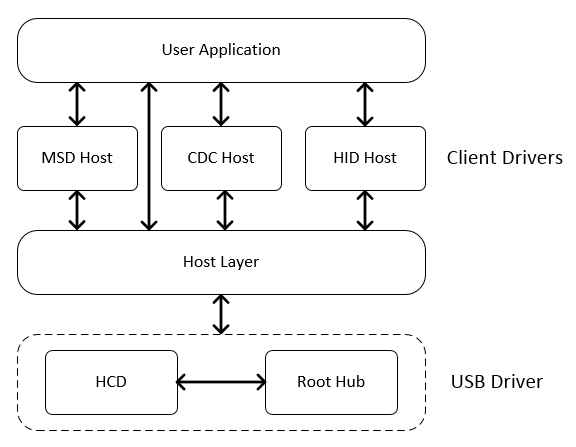The USB Host Library Architecture features a modular and layered architecture as illustrated in the following figure.
USB Host Library Architecture

As seen in the figure, the USB Device Library consists of the following three major components.
The HCD manages the state of the USB peripheral and provides the Host Layer with structured methods to access data on the USB. The HCD is a MPLAB Harmony driver and uses the MPLAB Harmony framework components (USB Peripheral Library and the Interrupt System Service) of its operation. The HCD is initialized in the system initialization routine and its tasks routine is invoked in the system tasks routine. It is accessed exclusively by the Host layer. The HCD provides the following services to the host layer:
- Establish and manage communication pipes between the host layer and the attached devices
- Manage USB transfers
The Root Hub Driver models the USB peripheral as a Hub. It then allows the Host Layer to perform the same actions on the Root Hub port that would be performed on an external Hub’s port. The Root Hub Driver thus leads to an optimized implementation of Hub support in the Host Layer. The Root Hub Driver is hardware specific and is implemented as a part of the HCD. It provides the following services to the Host Layer
- Provides device attach and detach events
- Allows the Host to suspend, resume, and reset the port
The Root Hub Driver works in tandem with the HCD to provides the Host Layer with required USB protocol related means and methods to manage the attached USB device.
The Host Layer receives attach and detach events from the Root Hub Driver. It enumerates attached devices based on information contained in the Target Peripheral List (TPL). It allows client drivers to access the attached device through Host Layer methods. This includes allowing the client driver to set the device configuration. Where the client driver does not set the device configuration, the Host Layer will set the device configuration.
The Host layer opens the HCD, instantiates the Root Hub Driver, then controls and communicates with the attached device. The user application can call the Host Layer API to get information on attached devices. It can also register a Host Layer Event handler to get device related events. The user application can additionally suspend or resume a device. The Host Layer also provides bus level control where the application can suspend or resume all devices connected to a USB.
The USB Host Stack Client Drivers implement the support for different device classes as per the class specifications. Along with Host Layer, the client drivers are designed to support multiple device of the same type (where multiple devices are connected to the host through a hub or is a single device with multiple interfaces). A client driver abstracts intricate details of the class specification and provides a high level command and data interface to the application. Completion of requests is indicated by events. The application must register an event handler to receive these events.
The Client Driver may manage devices whose functionality is specified by USB VID and PID. In such cases, the client driver can set the device configuration. The client driver may manage a device whose functionality is defined by an interface class, subclass and protocol. In such a case, the configuration is set by the Host layer. The client driver can also manage devices whose functionality is defined by a combination of VID PID and class, sub-class and protocol.
|
MPLAB Harmony USB Stack
|